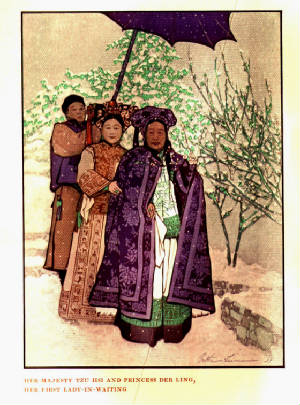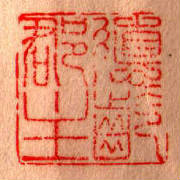|
When she was mortally
injured by a hit and run driver outside the University of California, Berkeley in November, 1944, the police report gave her
name as Mrs. Elizabeth Antoinette White. But on her death certificate, her husband insisted on adding: “Also known as
Princess Der Ling.” She died virtually forgotten - we may assume the clerk who had
to make her Chinese name and title fit the tiny space on the California death certificate grumbled over the task. But her
entertaining and insightful writings, as well as her desire to build bridges between east and west, still have much to teach
the present about China’s past and its future.
A memoirist, ranconteur,
and a European-educated, multi-lingual Asian woman who gleefully crossed all the lines of cultural expectations both oriental
and occidental, Princess Der Ling was a unique character on the stage of late Qing and early Republican China. A favorite lady-in-waiting to the Empress Dowager Cixi, she became that hated woman’s greatest apologist
and defender; and after moving to the United States in the late 1920’s, Der Ling sought through her seven books, numerous
articles and lectures to create understanding of China and Chinese history, while at the same time showing that a true daughter
of China could live western like the best of them.
Der Ling, as a personality
more than as inside chronicler of one of the most secretive courts in history, has been floating at the margins of Qing
dynasty history and historiography for some thirty years. She has appeared in
almost as many media as the empress dowager she tried to make the world understand: as a supporting character in Li Hanxiang’s
1976 film, The Last Tempest (speaking with a pronounced American accent), in Sterling Seagrave’s blockbuster
1992 biography of Cixi, Dragon Lady: The Life and Legend of the Last Empress of China (Knopf)-in which Seagrave makes an effort
to rehabilitate not just Cixi but Der Ling-and most recently in a University of Edinburgh thesis by Dr. Shiou-yun Fang, Images, Ideas, Reality
(2005). In addition, Der Ling’s account of being a student in Isadora Duncan’s early dance classes in Paris form
a strong part of the core of Peter Kurth’s acclaimed 2001 biography Isadora: A Sensational Life, and is in fact
where I first discovered Der Ling the person and the writer.
|
|
| Mr. and Mrs. Thaddeus C. White |
|
|
|
|
 |
|

|
| Painting of Der Ling and Cixi by Bertha Lum, 1933 |
For Bertha Lum's portrait of Der Ling, click here

|
| Der Ling's personal seal |
With
most of her books long out of print and her once ubiquitous face vanished from the news columns, Princess Der Ling [1885-1944]
is known to few people today. Yet this writer and cross-cultural celebrity has
as much to say about today’s congruence and collisions of East and West—in terms social, political, historical
and cultural—as she did over 80 years ago.
Like
that of Puyi, China’s last emperor, whom she first knew as an infant at the court of his imperial relative, Empress
Dowager Cixi, and would later try to help when his creditors came calling, Der Ling’s life writ large touches on issues
broader than even the vast Chinese landscape where she was born. Through the
courage of this Western-educated Manchu woman, who shocked Peking society dancing the Charleston, who fascinated gullible
New Yorkers by appearing at the opera in imperial Manchu court garments, a vista opens on an international cultural history
of the early- to mid-20th century.
Der Ling’s first and most famous book, Two Years in the Forbidden City (1912), which appeared the year the Manchu dynasty fell, glitters with the glamour
of a lost world, and served as an apologia not just for the ex-dynasty but for its most reviled ruler, the Empress Dowager
Cixi (1835-1908), the woman Der Ling had served as court lady, translator and surrogate daughter from 1903-1905. With the disintegration of the Romanov empire five years later, and the dispersal of its uprooted aristocrats
and intelligentsia through the world, a culture of the displaced celebrity launched this self-promoting Asian woman with the
tissue-thin title (and an American grandfather she never acknowledged) on a flood of general fascination with throneless royalty
and exotic pretenders.
My book is the first to deal with Der Ling as a phenomenon
of the fragmented, delirious era in which she lived, putting her recollections to the test while maintaining my opinion that
her memories of the last great Asian court and its society have much to teach us about the period, the people and East-West
relations. PartI deals with Der Ling’s beginnings, from her birth in Peking in June 1885 to her upbringing by her diplomat
father in Tokyo and Paris and her Western education; Part II covers Der Ling’s summons from Paris to the imperial Chinese
court by the Empress Dowager Cixi and her experiences of learning to know, fear and love this much-misunderstood woman; and
Part III deals with Der Ling’s authorship of her seven books and a critical appraisal thereof; her marriage to an American
and move to America, where her mystique flowered in an atmosphere of fascination with all things oriental and then died out
almost as totally as it had flourished.
|
|
|
|




